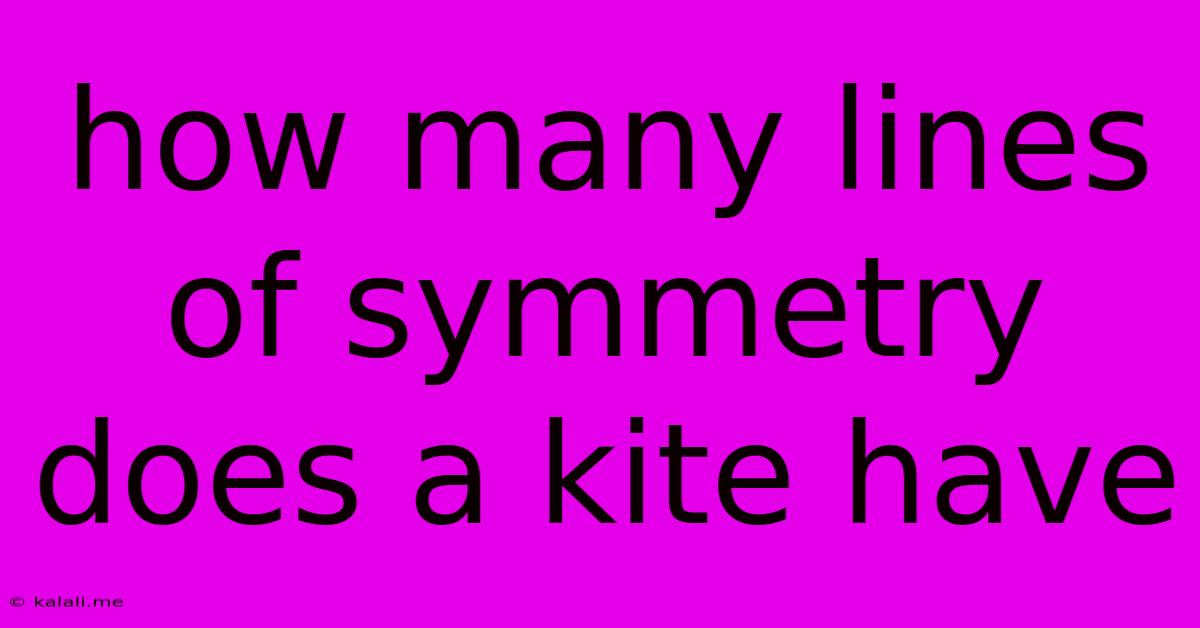How Many Lines Of Symmetry Does A Kite Have
Kalali
May 10, 2025 · 3 min read

Table of Contents
How Many Lines of Symmetry Does a Kite Have? A Comprehensive Guide
A kite, that cheerful four-sided shape, often brings to mind playful children's drawings and vibrant wind-blown toys. But beyond its whimsical appeal lies a fascinating geometric property: its lines of symmetry. Understanding how many lines of symmetry a kite possesses requires a clear understanding of what constitutes a kite and its properties. This article will delve into the specifics, helping you not only grasp the answer but also strengthen your understanding of symmetry in geometry.
A kite is defined as a quadrilateral with two pairs of adjacent sides that are equal in length. This means that two sides next to each other are the same length, and the other two sides next to each other are also the same length, but the two pairs of equal sides are not the same length as each other. This distinct characteristic dictates its symmetry, or rather, the lack thereof compared to other quadrilaterals.
Identifying Lines of Symmetry
A line of symmetry divides a shape into two identical halves, mirroring each other perfectly. To find the lines of symmetry in a kite, consider the following:
-
The Diagonal Connecting the Vertices of the Equal Sides: One line of symmetry always exists in a kite. This line connects the two angles where the pairs of equal sides meet. It bisects (cuts in half) the kite into two congruent (identical in shape and size) triangles. This diagonal also bisects the angles at the vertices it connects.
-
The Diagonal Connecting the Unequal Sides: The other diagonal of the kite, which connects the vertices of the unequal sides, is not a line of symmetry. While it does bisect the other diagonal, it does not divide the kite into two congruent halves. One half will be larger than the other.
Therefore, a kite typically has only one line of symmetry. There are exceptions.
Special Cases: The Rhombus and Square
It's crucial to understand that some kites are also rhombuses or squares. A rhombus is a kite where all sides are equal. A square is a rhombus with right angles.
-
Rhombus: A rhombus possesses two lines of symmetry, the diagonals intersecting at right angles.
-
Square: A square has four lines of symmetry - two diagonals and two lines connecting the midpoints of opposite sides.
These are special cases, however. A typical kite, with its unequal pairs of adjacent sides, has only one line of symmetry.
Conclusion: Understanding Symmetry in Kites
Understanding the lines of symmetry in a kite is not only about memorizing a number but about grasping the fundamental concept of geometric symmetry. By examining the definition of a kite and the conditions for a line of symmetry, we can clearly deduce that a typical kite possesses only one line of symmetry, highlighting the unique properties of this interesting geometric shape. Remember the exception of rhombuses and squares, which are special types of kites with higher symmetry. This knowledge is essential for various geometric problem-solving and visual reasoning tasks.
Latest Posts
Latest Posts
-
How Many Cups Are In A Pound Of Lard
Jun 30, 2025
-
Why Did Jerry Thompson And Kelly Nelon Divorce
Jun 30, 2025
-
Allen And Roth Patio Furniture Replacement Parts
Jun 30, 2025
-
How Many Minutes Are In 20 Miles
Jun 30, 2025
-
How Many Days Is 72 Hours From Tuesday
Jun 30, 2025
Related Post
Thank you for visiting our website which covers about How Many Lines Of Symmetry Does A Kite Have . We hope the information provided has been useful to you. Feel free to contact us if you have any questions or need further assistance. See you next time and don't miss to bookmark.